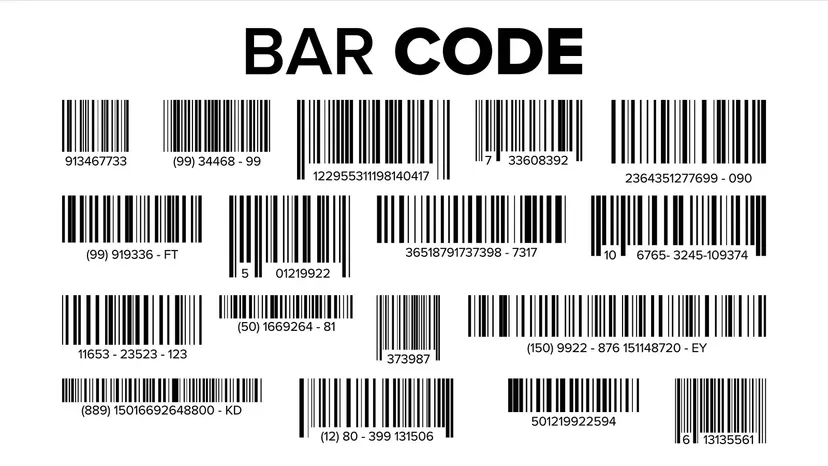The Importance of Barcode Number Details in Product Identification
 The Importance of Barcode Number Details in Product Identification
The Importance of Barcode Number Details in Product Identification
In every industry, the importance of barcode number details can not be avoided. For each product or service you sell, you will have to make a barcode for the product to stay unique and make your products interoperable in the market. This blog will be a guide to uncovering the role barcodes play in unique product identification and the benefits they provide at different levels.
Introduction
Barcodes encode unique product identification numbers that are presented in a series of parallel lines of varying widths (1D barcode) and spaces or patterns of circles, boxes, and dots (2D barcode), in a machine-readable format. The identification number in the barcodes makes products in the supply chain unique. Barcode number details contain information such as name, expiry, manufacturing date, location, nutritional information, etc. about the products and services which can be extracted by people using scanners or by simply using their mobile phones in the case of 2D barcodes.
When businesses make barcode for product they empower consumers, manufacturers, and retailers with accurate and authentic product information. The details encoded in them can be accessed by everyone for product identification purposes.
Understanding Barcode Numbers
Barcode numbers are a unique set of identification numbers of varying lengths, that are provided to companies to sell products or services in the market, by GS1. These numbers contain four basic elements, the Global Company Prefix (GCP) which is a combination of Country Code and Company Code, Product Code, and the Check Digit.
890 is the country code for India, the company code is assigned by GS1 India to companies, the product code is provided by the company, and the check digit is calculated based on a mathematical algorithm.
Types of Barcode Numbers
1D Barcode Types
UPC-A Barcode – The UPC-A barcode is mostly used in North America and is accepted globally. UPC stands for Universal Product Code. It contains 12 digits that are used to uniquely identify products and services.
UPC-E Barcode – The UPC-E barcode is a compressed version of UPC-A. It contains 8 digits and is used to identify products where the packaging is small, such as cosmetics, candy, trial items, etc.
EAN-13 Barcode – EAN stands for European Article Number. EAN-13 has 13 digits and is used and accepted globally.
EAN-8 Barcode – EAN-8 is a compressed version of EAN-13. Similar to UPC-E, it is used to identify smaller products outside of North America.
GS1-128 Barcode – The GS1-128 barcode is applied in the logistics units. It can contain additional information such as expiry date, manufacturing date, and batch number and encodes either Global Trade Identification Number (GTIN) or Serial Shipping Container Code (SSCC).
ITF-14 Barcode – This barcode is suited for corrugated materials and is not scanned at the point of sale. It is used for larger products, such as pallets and cases, in the distribution and logistic process.
2D Barcode Types
QR Code Barcode – This type is an advanced method of presenting product information. Unlike all the other 1D barcodes, this can be scanned via phone. Companies can encode a URL in the QR code which can then be accessed by people upon scanning.
Data Matrix Barcode – This type of 2D barcode can encode a large amount of information and is specifically used in the healthcare sector.
GS1 DotCode – GS1 DotCode are the barcodes that are used only for EU Tobacco Traceability regulation EU 2018/574.
Role of Barcode Number Details in Product Identification
By now you have learned what a barcode is and the types of barcodes, listed below are some of the roles barcodes play –
- Accuracy in Inventory Management – If you are someone who is involved in the sales of products through retail, online commerce, exports, and in the healthcare industry it is paramount to register for barcodes and make barcode for product to achieve accuracy in inventory management. Barcodes allow you to track your inventory levels efficiently and update your stocks on time or whenever needed.
- Efficient Product Lookup – Products can be smartly identified as they are located in a centralized database when they have barcodes on them. The unique identification number allows retailers to verify the details at point-of-sale and charge people with correct prices.
- Preventing Errors – Barcode number details prevent errors as there is no manual product data entry. This further reduces the likelihood of data discrepancies and mismanagement of inventory levels.
How Barcode Number Details Enhance Supply Chain Efficiency
Details provided on the barcode can enhance supply chain efficiency, here are a few reasons for how –
- Streamlining Logistics – Business owners and manufacturers can streamline their logistics and shipping with barcodes. They provide better order fulfillment, promoting a transparent and efficient supply chain process.
- Tracking and Tracing – Barcodes allow business owners to track their products throughout the supply chain. The unique identification can be traced to track the movement of the product and thus reduce the probability of adulteration and counterfeiting. Detailed barcode numbers further provide extensive information about the product, right from the origin to its procurement, making it easier for businesses to recall in case of exigency.
Impact on Consumer Experience
Barcodes deeply impact consumer behaviour and brand-user relationships. Enlisted are some of the benefits consumers enjoy because of barcodes –
- Improving Checkout Speed – Long queues are always a headache for consumers, especially when details are being entered manually. This decreases the consumer satisfaction level and loyalty. The unique identification number in barcodes can be swiftly scanned at checkouts to interpret product information within seconds. This in turn elevates checkout speed and increases consumer satisfaction levels.
- Product Information Access – Consumers get access to unrestricted product information which they can utilise to make informed purchase decisions. Having information readily available at the tap of phones boosts consumer confidence in the brand and its products. Additionally, barcode numbers act as a guarantee of authentic product information which further increases brand loyalty among consumers.
Compliance and Standards
There is only one standardised body to formulate and implement compliance and standards for barcodes globally, GS1. If you want to get barcodes it is advised you obtain GS1 barcodes only as these are the only barcodes that are interoperable, structured, and unique. The GS1 barcodes are based on three fundamental standards; Identify, Capture, and Share. In India, GS1 India, a member organisation of GS1 Global, is the only authorised body which can provide you with barcodes. Adhering to GS1 standards and protocols ensures your products are compliant with the market requirements.
Future Trends and Innovations
The world is now shifting its gears to embrace 2D barcode technology over 1D barcode. In the coming years, Radio Frequency Identification (RFID) will be used predominantly across various industries, making traceability and tracking of products easier than ever. Not to forget, blockchain technology will be the next transformational wave and will completely revolutionise the way businesses operate. It will foster increased scrutiny at different levels of the product lifecycle.
Conclusion
If you are a new business owner or want to register yourself for barcodes, now is the right time to do so. Building consumer confidence and loyalty is key to achieving success for any business and obtaining authorised and standardised barcodes will help you achieve this. Uniquely identify your products and sell them anywhere across the globe with barcodes. In India, only GS1 India is authorised to provide any company with barcodes, so make sure you are registered with it. Barcode numbers will serve no purpose if they are outdated, it is advised after you make barcode for product keep updating the information and images in the data repository so there are no discrepancies in data entry.







